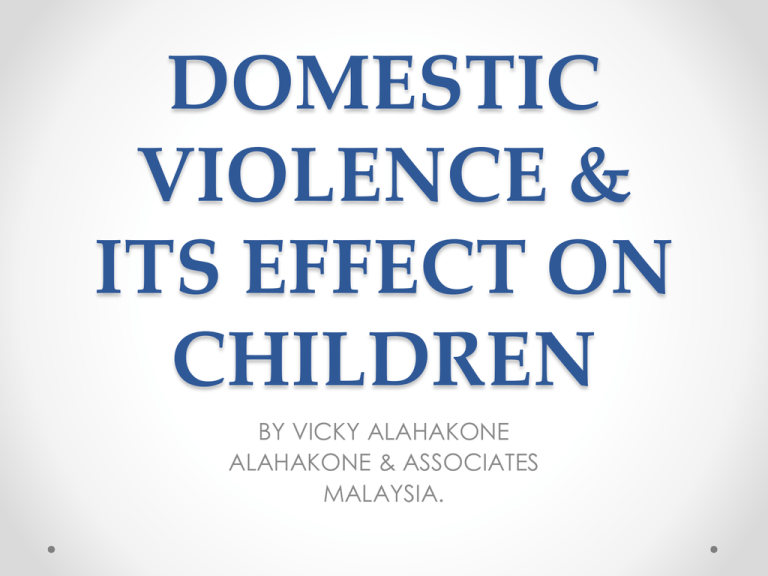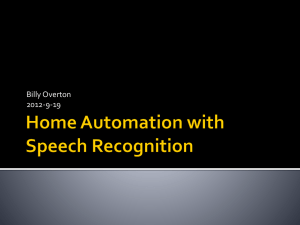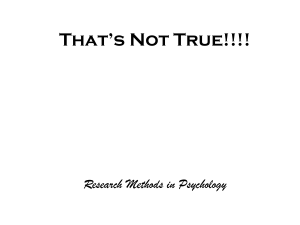
DOMESTIC
VIOLENCE &
ITS EFFECT ON
CHILDREN
BY VICKY ALAHAKONE
ALAHAKONE & ASSOCIATES
MALAYSIA.
Child Protection Acts &
Policies in Malaysia
•
•
•
•
•
•
•
•
•
•
Child Act 2001
Domestic Violence Act 1994
Penal Code
Evidence Act - 1950
Criminal Procedure Code (CPC)
Evidence of Child Witness Act 2007
Convention of the Rights of Children (CRC)
National Child Protection Policy (NCPP)
National Policy on Children
National Policy on reproductive plan & social
education.
Domestic Violence
Defined
When a child has been:
• Physically injured
• Emotionally injured
• Sexually abused
Physical Injury
A result of non accidental application of force on Child’s Body
•
•
•
•
•
•
•
Laceration
Contusion
Abrasion
Fracture
Dislocation
Sprain
Haemorrhaging
•
•
•
•
•
•
Rupture of viscus
Scalding
Burns
Loss of Consciousness
Loss of Hair
Loss of Teeth
Emotional Injury
Observable Impairment of Child
•
•
•
•
•
•
Mental or behavioural disorder
Anxiety
Depression
Withdrawal
Aggression
Late Development
Sexual Abuse
Participating or observing activities which are sexual in nature :
• Pornographic
• Publication of Indecent
Materials
• Obscene Photographs
• Obscene recording
• Sexual exploitation for
another persons sexual
gratification
Common Cause of
Emotional Abuse
•
•
•
•
During custody battles
Brain washing
Child Put in fear of loss on one parent
Child put in fear of physical violence
Events After Disclosure
• Dysfunctional Family
• Lack of parental support
(Disbelief, Denial, Secrecy, Rejection)
• Giving testimony against the abuser
• Post traumatic stress disorder
Attitude Towards Self &
Others
•
•
•
•
•
•
•
•
•
•
•
•
•
Negative self concept
Ambivalence to non offending parent
Sense of powerlessness
Expectation of betrayal
Threat to family integrity
Depression/aggression/ sexual problems
High drop out rate
Delayed development
Indifference/disassociation
Disruptive or impulsive behaviour
Withdrawal
Anxiety Attack
Mental Behavioural Disorder
National Child Protection
Policy 2009
• Setting up of 24 hour Helpline (Talian Nur-15999)
Pros
• Attend to calls from
adults only.
Cons
• Operators not trained to
handle distress calls.
• Members of public able
to report child abuse
cases directly to
authorities.
• Callers will be referred to
relevant NGOs & Social
Welfare Department.
• Too many prank calls.
• Toll Free Line.
• Calls streamed and
referred directly to
Social Welfare
Department.
National Child Protection
Policy 2009
• Setting up of 24 hour Helpline (Child Line - 15999)
Pros
• Operators trained to
handle calls from
children.
• Calls are Toll Free.
Cons
• Operators are paracounsellors – need to
refer calls to relevant
child protectors.
• Too many prank calls
National Child Protection
Policy 2009
• Setting up of 24 hour (Nur Alert – By Subscription Only.)
Pros
• Royal Malaysian Police
disseminates the alerts to
the government & Non
government agencies.
• Members who have
subscribed will be notified
immediately.
• Missing children go viral.
Cons
• Only members who have
subscribed will be
alerted.
• Public not aware and
educated on the
difference between Talian
NUR and NUR-Alert.
• Not many subscribers.
• Only 5 reported cases on
NUR Alert.
Data of Child Abuse
2009- 2011
Data of Child Abuse by
Ethnic & Sex
Inter Agency
Organizations
•
•
•
•
•
One stop crisis centres
Children’s Homes
Child protection Teams
Child Activities Centres
Child Interview Centres
One Stop Crisis Centre
Pros
• One centre for victims
of abuse and rape to
receive help from the
medical, police &
social welfare
departments.
Cons
•
•
•
•
•
•
Delay in investigation
Medical reports not available
immediately
Shortage of welfare officers,
therefore victims lack counselling
services.
No protection given to victims
once discharged from hospital.
Admitted child exposed to other
children who are admitted and
undergoing different
psychological programs.
Lack of One Stop Crisis Centres in
all states & towns especially rural
areas.
Children’s Homes
Pros
• Established to provide
safety for victims of
violence.
• Partnership projects
between corporate
bodies & welfare
departments.
• Temporary shelter for
children.
Cons
• Homes over crowded.
• Children left in care of
untrained personnel.
• Children exposed to
various psychological
issues suffered by other
children.
• Lack of funds and
financing by the
government.
• Lack of trained resident
counsellors.
Child Protection Teams
Pros
Cons
• Set up at State &
District Levels in high risk
areas.
• Enables community to
implement preventive
& rehabilitative
programs.
• Builds awareness
among public and
involves volunteers
• Lack of volunteers.
• Insufficient Training
provided.
• No support system from
authorities to back up
teams.
Child Activities Centres
Pros
• Centre for children to
collect and meet
• Carry out creative,
recreational and sports,
and support services for
families.
• Handles social
problems such as child
abuse, neglect,
truancy, delinquency,
and drug abuse
Cons
• Lack of trained
personnel to manage
centres.
• Lack of activities.
• Stigma to be seen
participating or
actively involved in the
activities in these
centres.
Child Interview Centres
Pros
Cons
• Managed by the Royal
Malaysian Police to
take statements, video
recordings & collect
evidence from child
victims and witnesses.
• Need to train and
sensitise police towards
children when taking
evidence.
• Delay in undertaking
interviews with children.
Child Victims in the
Malaysian Courts
• Child victims devoid of legal assistance during court
proceedings.
• Lack of protection provided to victim and families,
pending proceedings.
• Children not familiarized with court proceedings
prior to trial.
Child Representation in
the Malaysian Court
• No provision for lawyers to represent children in
court proceedings.
• Children not familiar with court and proceedings.
• No party to liaise with police on behalf of child.
• Lack of advice for children.
• No appointment of child advocate/friend to
accompany child to court.
• Watching brief for family of child. Limited role for
lawyer during proceedings.
Burden on Child
• Preparation of child to give evidence in
court.
• Attendance in court with accused.
• Effects of cross examination on child.
• Consequences of court postponements on
child.
• Delayed trials.
• Need for child to recount incident until trial is
over.
The Protectors
•
•
•
•
•
•
•
•
Police Officers
Doctors
Welfare Officers
Parents
Guardians
Foster Parents
Psychologists/ Psychiatrists
No Lawyers
Role of Magistrates
• Ensure safety of child victims and witnesses.
• Cases given priority hearings.
• Facilitate evidence of child to be taken via video
link/ separated by a screen/ other arrangements.
• Sensitised to needs of children.
Inter Agency
Collaboration
• Need for relevant authorities to collaborate to assist
victims.
• Need for centres to be set up in rural areas.
• Cooperation required between agencies.
• Authorities to protect and place the needs of the
children above other unconditionally.









